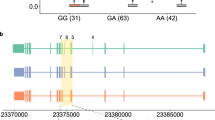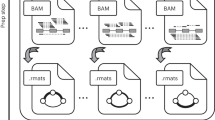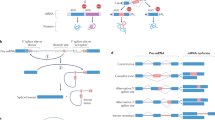Abstract
Recent genome-wide analyses of alternative splicing indicate that 40–60% of human genes have alternative splice forms, suggesting that alternative splicing is one of the most significant components of the functional complexity of the human genome. Here we review these recent results from bioinformatics studies, assess their reliability and consider the impact of alternative splicing on biological functions. Although the 'big picture' of alternative splicing that is emerging from genomics is exciting, there are many challenges. High-throughput experimental verification of alternative splice forms, functional characterization, and regulation of alternative splicing are key directions for research. We recommend a community-based effort to discover and characterize alternative splice forms comprehensively throughout the human genome.
This is a preview of subscription content, access via your institution
Access options
Subscribe to this journal
Receive 12 print issues and online access
$209.00 per year
only $17.42 per issue
Buy this article
- Purchase on Springer Link
- Instant access to full article PDF
Prices may be subject to local taxes which are calculated during checkout




Similar content being viewed by others
References
Pennisi, E. Human genome project: and the gene number is...? Science 288, 1146–1147 (2000).
Adams, M.D. et al. The genome sequence of Drosophila melanogaster. Science 287, 2185–2195 (2000).
The C. elegans Sequencing Consortium. Genome sequence of the nematode C. elegans: a platform for investigating biology. Science 282, 2012–2018 (1998).
International Human Genome Sequencing Consortium. Initial sequencing and analysis of the human genome. Nature 409, 860–921 (2001).
Venter, J.C. et al. The sequence of the human genome. Science 291, 1304–1351 (2001).
Sambrook, J. Adenovirus amazes at Cold Spring Harbor. Nature 268, 101–104 (1977).
Gilbert, W. Why genes in pieces? Nature 271, 501 (1978).
Early, P. et al. Two mRNAs can be produced from a single immunoglobulin m gene by alternative RNA processing pathways. Cell 20, 313–319 (1980).
Rosenfeld, M.G. et al. Calcitonin mRNA polymorphism: peptide switching associated with alternative RNA splicing events. Proc. Natl Acad. Sci. USA 79, 1717–1721 (1982).
Sharp, P.A. Split genes and RNA splicing. Cell 77, 805–815 (1994).
Lopez, A.J. Alternative splicing of pre-mRNA: developmental consequences and mechanisms of regulation. Annu. Rev. Genet. 32, 279–305 (1998).
Boise, L.H. et al. bcl-x, a bcl-2-related gene that functions as a dominant regulator of apoptotic cell death. Cell 74, 597–608 (1993).
Smith, C.W.J. & Valcarcel, J. Alternative pre-mRNA splicing: the logic of combinatorial control. Trends. Biochem. Sci. 25, 381–388 (2000).
Mironov, A.A., Fickett, J.W. & Gelfand, M.S. Frequent alternative splicing of human genes. Genome Res. 9, 1288–1293 (1999).
Croft, L. et al. ISIS, the intron information system, reveals the high frequency of alternative splicing in the human genome. Nature Genet. 24, 340–341 (2000).
Brett, D. et al. EST comparison indicates 38% of human mRNAs contain possible alternative splice forms. FEBS Lett. 474, 83–86 (2000).
Kan, Z., Rouchka, E.C., Gish, W.R. & States, D.J. Gene structure prediction and alternative splicing analysis using genomically aligned ESTs. Genome Res. 11, 889–900 (2001).
Modrek, B., Resch, A., Grasso, C. & Lee, C. Genome-wide analysis of alternative splicing using human expressed sequence data. Nucleic Acids Res. 29, 2850–2859 (2001).
Burset, M., Seledtsov, I.A. & Solovyev, V.V. Analysis of canonical and non-canonical splice sites in mammalian genomes. Nucleic Acids Res. 28, 4364–4375 (2000).
Beaudoing, E., Freier, S., Wyatt, J.R., Claverie, J. & Gautheret, D. Patterns of variant polyadenylation signal usage in human genes. Genome Res. 10, 1001–1010 (2000).
Graveley, B.R. Alternative splicing: increasing diversity in the proteomic world. Trends Genet. 17, 100–107 (2001).
Wheeler, D.L. et al. Database resources of the National Center for Biotechnology Information. Nucleic Acids Res. 28, 10–14 (2000).
Burke, J., Wang, H., Hide, W. & Davison, D.B. Alternative gene form discovery and candidate gene selection from gene indexing projects. Genome Res. 8, 276–290 (1998).
Shoemaker, D.D. et al. Experimental annotation of the human genome using microarray technology. Nature 409, 922–927 (2001).
Hu, G.K. et al. Predicting splice variant from DNA chip expression data. Genome Res. 11, 1237–1245 (2001).
Krawzczak, M., Reiss, J. & Cooper, D.N. The mutational spectrum of single base-pair substitutions in mRNA splice junctions of human genes: causes and consequences. Hum. Genet. 90, 41–54 (1992).
Liu, H.X., Cartegni, L., Zhang, M.Q. & Krainer, A.R. A mechanism for exon skipping caused by nonsense or missense mutations in BRCA1 and other genes. Nature Genet. 27, 55–58 (2001).
Stamm, S., Zhang, M.Q., Marr, T.G. & Helfman, D.M. A sequence compilation and comparison of exons that are alternatively spliced in neurons. Nucleic Acids Res. 22, 1515–1526 (1994).
Kent, W.J. & Zahler, A.M. Conservation, regulation, synteny, and introns in a large-scale C. briggsae–C. elegans genomic alignment. Genome Res. 10, 1115–1125 (2000).
Stamm, S. et al. An alternative-exon database and its statistical analysis. DNA Cell Biol. 19, 739–756 (2000).
Brudno, M. et al. Computational analysis of candidate intron regulatory elements for tissue-specific alternative pre-mRNA splicing. Nucleic Acids Res. 29, 2338–2348 (2001).
Modafferi, E.F. & Black, D.L. A complex intronic splicing enhancer from the c-src pre-mRNA activates inclusion of a heterologous exon. Mol. Cell. Biol. 17, 6537–6545 (1997).
Huh, G.S. & Hynes, R.O. Regulation of alternative pre-mRNA splicing by a novel repeated hexanucleotide element. Genes Dev. 8, 1561–1574 (1994).
Hedjran, F., Yeakley, J.M., Huh, G.S., Hynes, R.O. & Rosenfeld, M.G. Control of alternative pre-mRNA splicing by distributed pentameric repeats. Proc. Natl Acad. Sci. USA 94, 12343–12347 (1997).
Kawamoto, S. Neuron-specific alternative splicing of nonmuscle myosin II heavy chain-B pre-mRNA requires a cis-acting intron sequence. J. Biol. Chem. 271, 17613–17616 (1996).
Dralyuk, I., Brudno, M., Gelfand, M.S., Zorn, M. & Dubchak, I. ASDB: database of alternatively spliced genes. Nucleic Acids Res. 28, 296–297 (2000).
Ji, H. et al. AsMamDB: an alternative splice database of mammals. Nucleic Acids Res. 29, 260–263 (2001).
Spingola, M., Grate, L., Haussler, D. & Ares, M.J. Genome-wide bioinformatic and molecular analysis of introns in Saccharomyces cervisiae. RNA 5, 221–234 (1999).
Kent, W.J. & Zahler, A.M. The intronerator: exploring introns and alternative splicing in Caenorhabditis elegans. Nucleic Acids Res. 28, 91–93 (2000).
Acknowledgements
We are grateful to D. Black, S. Galbraith and K. Ke for their critical comments and suggestions. C.L. was supported by a grant from the Department of Energy. B.M. was supported by National Science Foundation Integrative Graduate Education and Research Training award.
Author information
Authors and Affiliations
Corresponding author
Rights and permissions
About this article
Cite this article
Modrek, B., Lee, C. A genomic view of alternative splicing. Nat Genet 30, 13–19 (2002). https://doi.org/10.1038/ng0102-13
Received:
Accepted:
Issue Date:
DOI: https://doi.org/10.1038/ng0102-13
This article is cited by
-
Expression and functional analysis of ace1 and ace2 reveal their differential roles in larval growth and insecticide sensitivity in Spodoptera frugiperda (J. E. Smith, 1797)
Journal of Pest Science (2023)
-
ROCK2-RNA interaction map reveals multiple biological mechanisms underlying tumor progression in renal cell carcinoma
Human Cell (2023)
-
Tissue-Specific Analysis of Alternative Splicing Events and Differential Isoform Expression in Large Yellow Croaker (Larimichthys crocea) After Cryptocaryon irritans Infection
Marine Biotechnology (2022)
-
The influence of environmental and core temperature on cyclooxygenase and PGE2 in healthy humans
Scientific Reports (2021)
-
Overlapping roles of spliceosomal components SF3B1 and PHF5A in rice splicing regulation
Communications Biology (2021)



